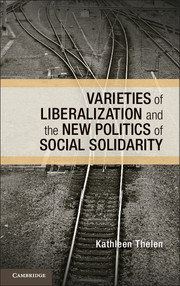Book contents
- Frontmatter
- Dedication
- Contents
- List of Figures
- List of Tables
- List of Abbreviations
- Preface
- 1 Varieties of Liberalization and the New Politics of Social Solidarity
- 2 Industrial Relations Institutions
- 3 Vocational Education and Training
- 4 Labor Market Policy
- 5 Coalitional Realignments and Institutional Change
- 6 The Future of Egalitarian Capitalism, in Light of Its Past
- Appendix A Components of Index and Descriptions of Variables for Figure 1.1
- Appendix B Components of Index for Figures 6.2 and 6.3
- Bibliography
- Index
5 - Coalitional Realignments and Institutional Change
Published online by Cambridge University Press: 05 June 2014
- Frontmatter
- Dedication
- Contents
- List of Figures
- List of Tables
- List of Abbreviations
- Preface
- 1 Varieties of Liberalization and the New Politics of Social Solidarity
- 2 Industrial Relations Institutions
- 3 Vocational Education and Training
- 4 Labor Market Policy
- 5 Coalitional Realignments and Institutional Change
- 6 The Future of Egalitarian Capitalism, in Light of Its Past
- Appendix A Components of Index and Descriptions of Variables for Figure 1.1
- Appendix B Components of Index for Figures 6.2 and 6.3
- Bibliography
- Index
Summary
The previous chapters have explored the ways in which the decline of employment in manufacturing and the transition to services have unsettled previously stable arrangements across all three of the institutional arenas under analysis here. The broad trajectory of change – in industrial relations, in vocational education and training, and in labor market policy – across all three countries is toward liberalization. This should be seen as a validation of liberalization arguments (notably Streeck 2009; also Baccaro and Howell 2011). Yet we have also seen that there are distinct varieties of liberalization, driven forward by different political dynamics and also associated with different distributional outcomes.
Writing in 1985, Gøsta Esping-Andersen argued that the political viability of the more egalitarian varieties of capitalism involves forming and maintaining alliances that shift in response to changes in class structures as capitalism itself evolves. Social democracy's traditional core constituencies – above all, blue-collar workers in industry – remain central actors in this process, not least because manufacturing itself remains a vital part of the political economies in these countries. However, as Esping-Andersen anticipated, declining employment in manufacturing also means that the survival of social democracy hinges crucially on the new coalitions these groups are able to forge with emerging new class actors – particularly lower-skill workers in the growing service sectors, but also salaried employees and white-collar workers generally. Building on the core insights that Esping-Andersen developed in his analysis of social and welfare policies, I submit that in order to explain observed distinctive trajectories of liberalization in the three arenas examined in this book, we can do no better than to ask how and to what extent such alliances are taking shape.
- Type
- Chapter
- Information
- Publisher: Cambridge University PressPrint publication year: 2014
- 1
- Cited by



